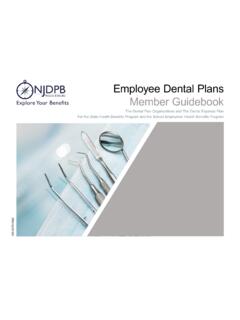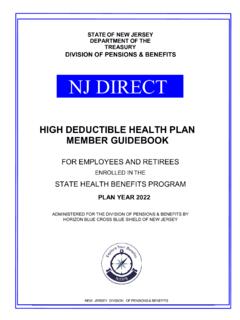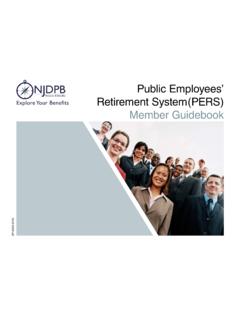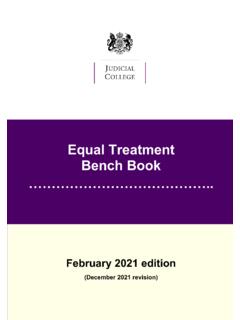Transcription of Equal Treatment Bench Book - Judiciary
1 Equal Treatment Bench Book .. February 2021 edition Contents The Equal Treatment Bench Book is a dynamic document. In the event that you choose to print or download it, please be aware that it is subject to modification and improvement from time to time. Contents Foreword ..1. Foreword (to the February 2018 edition) ..2. Acknowledgments ..3. Introduction: Equal Treatment and the Judge ..5. Introduction .. 5. Good communication .. 6. Demonstrating fairness .. 7. Diversity .. 8. A note on terminology .. 9. England and Wales: A Single Legal Jurisdiction .. 10. The Welsh Language: Official 10. Chapter 1 Litigants in Person and Lay Representatives .. 11. Contents .. 11. Overview .. 12. Litigants in person ( LIPs') .. 15. The courts' duty to LIPs .. 16. Difficulties faced by LIPs .. 17. Ways to help.
2 17. Holding the confidence of both sides .. 17. Sources of outside help and information for LIPs .. 18. Particular areas of difficulty .. 18. Language .. 18. Disability .. 19. Social and educational background .. 19. Common procedural misunderstandings in case preparation .. 19. Statements of case / Pleadings and limitation periods .. 19. Case management: understanding directions and court orders .. 20. Equal Treatment Bench Book i Contents Disclosure of documents .. 23. Understanding the importance of documentary evidence .. 24. Trial bundles .. 24. Witnesses and witness statements .. 25. Adjournments .. 26. Case law .. 26. Compromise .. 27. Difficulties at the hearing and how to help .. 28. Introductory explanations by the 28. The real issues of the case .. 29. Advocacy .. 29. Giving judgment.
3 31. Criminal cases .. 31. Useful guidance materials .. 31. Guilty pleas .. 31. The value of representation .. 32. Assistance during the trial .. 32. Jargon and legalese .. 35. Assistance and representation from lay representatives .. 36. Overview .. 36. Lay representatives and tribunals .. 36. McKenzie Friends' .. 37. Support Through Court & Citizens Advice .. 39. Rights of audience .. 40. Small Claims .. 42. Housing Authority Officers and Employees of Arm's Length Management Organisations [ALMOs] .. 42. Companies .. 42. Official Receivers .. 42. Official Solicitor .. 42. Representing adults who lack capacity .. 43. References and resources .. 43. References .. 43. Cases .. 44. Other .. 44. Equal Treatment Bench Book ii Contents Chapter 2 Children, Young People and Vulnerable Adults ..45.
4 Contents .. 45. Overview .. 46. Who is covered by this chapter? .. 49. The rights of young and vulnerable witnesses to effective participation .. 50. Vulnerability of young and adult offenders .. 51. The duty to safeguard children and vulnerable adults .. 53. Safeguarding generally .. 53. Safeguarding in courts and tribunals .. 53. The Judiciary 's role in safeguarding .. 54. Competence .. 55. The need to adapt procedures .. 56. Expedited time-scales and active case management .. 58. Rules and materials .. 58. Timetabling .. 59. Avoiding adjournments .. 61. Scheduling a clean start' to witness testimony .. 61. Special measures, participation directions and related 63. Special 63. Disapplying special measures .. 64. Participation directions in the family court .. 64. Avoiding 65. Screens .. 66.
5 Evidence by live link .. 66. Refreshing witness memory .. 68. Intermediaries: facilitating complete, coherent and accurate communication .. 69. The function .. 69. Should an intermediary be appointed? .. 71. If the application is contested .. 71. If the intermediary is not available on the day .. 72. Intermediaries in family cases .. 72. Non-registered intermediaries for vulnerable defendants in criminal proceedings .. 73. Sources of other information about intermediaries .. 75. Communication aids recommended by intermediaries .. 75. Equal Treatment Bench Book iii Contents Ground rules hearings .. 75. Function of ground rules hearings .. 75. Topics for discussion at a ground rules hearing .. 76. Trial practice note of boundaries .. 77. Sources of other information on ground rules hearings.
6 77. Adjustments to cross-examination .. 78. The court's duty to control 78. Limiting the length of cross-examination .. 79. Questioning techniques to avoid .. 79. Questions about third party material .. 81. Reporting restrictions .. 82. Communicating at trial .. 83. Before the vulnerable person gives evidence .. 83. Simplified instructions from the judge or magistrate .. 83. While the vulnerable person is giving evidence .. 84. Information for the jury .. 84. The judgment .. 86. Further examples of adapting procedures(disability) .. 86. The importance of routine feedback .. 87. References and resources .. 87. References .. 87. The Advocate's Gateway .. 89. Cases .. 90. Conventions .. 91. Chapter 3 Physical Disability .. 92. Contents .. 92. Overview .. 93. What is physical disability? .. 96.
7 Why this chapter matters .. 96. Who do these considerations apply to? .. 97. Difficulties the court process may pose for disabled people .. 98. Identifying an individual's needs .. 98. Necessary advance planning .. 98. Consultation, case management and ground rules hearings .. 99. Adjustments for case preparation .. 100. Equal Treatment Bench Book iv Contents Adjustments for the hearing .. 100. General examples of 100. Breaks and shorter hours .. 102. Communication .. 102. Representation .. 103. What if the individual does not raise the subject of disability? .. 103. Criminal court procedure statutory measures .. 103. Jury service and disability .. 104. Acceptable terminology .. 106. How to discuss someone's possible needs in court .. 106. The social model v the medical model of 106. Use of terms.
8 107. The legal definition of disability' .. 108. References and resources .. 108. References .. 108. Cases .. 109. Practice Directions, Guidance Notes and Conventions .. 109. Chapter 4 Mental Disability .. 110. Contents .. 110. Overview .. 111. What is mental disability? .. 115. Prevalence of mental health difficulties .. 115. Why this chapter matters .. 117. Difficulties the court process may pose for mentally disabled people .. 118. Identifying an individual's needs .. 119. Necessary advance planning .. 119. Consultation, case management and ground rules hearings .. 120. Adjustments for case preparation .. 121. Adjustments for the hearing .. 122. General examples of 122. Breaks and shorter hours .. 124. Communication .. 124. Adjustments to cross-examination .. 125. Memory .. 126. Representation.
9 127. Equal Treatment Bench Book v Contents What if the individual does not raise the subject of disability? .. 127. Criminal court procedure statutory measures .. 128. Mental disability and remote hearings .. 129. Mental health: defendants and the criminal justice system .. 131. Prisoners and mental health .. 131. Ways to find out whether the defendant has a mental health condition .. 132. Mental Health Liaison and Diversion Services .. 132. Bail and remand decisions .. 133. The trial .. 133. Sentencing .. 134. Veterans .. 136. Mental 136. The cause of veterans' mental health difficulties .. 137. Veterans and the criminal justice system .. 138. The Armed Forces Covenant .. 139. Acceptable terminology .. 139. How to discuss someone's possible needs in court .. 139. The social model v the medical model of 140.
10 Use of terms .. 140. The legal definition of disability' .. 141. The Equality Act 2010 .. 141. References and resources .. 141. References .. 141. Cases .. 143. Conventions .. 144. Chapter 5 Capacity (Mental) .. 145. Contents .. 145. Overview .. 146. Criteria for assessing capacity .. 147. The approach of different professions .. 147. Assessment of capacity .. 148. Presumption of capacity .. 148. Determining 148. Evidence .. 149. Implications .. 149. Equal Treatment Bench Book vi Contents Guidance .. 149. The Mental Capacity Act 2005 .. 150. Background and overview .. 150. Fundamental principles .. 151. The concept of incapacity' under the MCA .. 151. The concept of best interests' under the MCA .. 151. 152. The public bodies created by the MCA .. 152. The jurisdiction under the MCA .. 153.

















